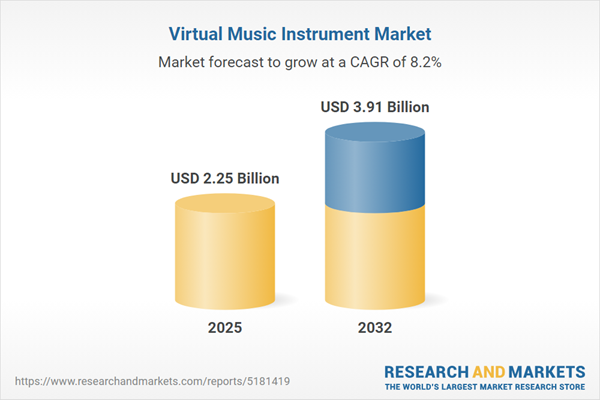Speak directly to the analyst to clarify any post sales queries you may have.
The virtual music instrument market is experiencing rapid evolution, shaped by technological innovation, rising user diversity, and global shifts in music creation and production workflows.
Market Snapshot: Virtual Music Instrument Market Growth and Trends
The Virtual Music Instrument Market is witnessing significant momentum, with a clear trajectory of robust compound annual growth into the next decade. Driven by advances in digital signal processing, cloud collaboration, and widespread mobile adoption, virtual instruments are expanding accessibility and transforming sound production. This dynamic environment enables organizations to anticipate shifting demands and align product portfolios accordingly, supported by a healthy expansion rate from 2024 through 2032.
Scope & Segmentation Across Technologies and Regions
- Instrument Type: Hardware-based products (including digital audio workstations and MIDI controllers) and a broad array of software-based options such as virtual drums, orchestral instruments, pianos, and synthesizers
- Platform: Mobile-based instruments and PC-based environments, each catering to unique workflow preferences and user groups
- Pricing Structure: Freemium models, one-time purchases, and subscription-based solutions that address diverse buyer needs and enable flexible pricing strategies
- Application: Educational tools, live performance capabilities, and music production enhancements supporting different use cases and professional requirements
- End User: Hobbyists, educational institutions, and professional musicians integrating digital tools into everyday practice
- Geographic Reach: Detailed market coverage includes North America, Latin America, Europe, Middle East, Africa, and Asia Pacific, examining region-specific adoption patterns and innovation drivers
- Company Coverage: Insight into offerings from leading vendors such as Ableton AG, Yamaha Music Private Limited, Native Instruments GmbH, IK Multimedia Productions SRL, EastWest Studios, Arturia, Spitfire Audio Holdings Ltd., Reason Studios AB, and UJAM Music Technology GmbH, as well as niche developers emphasizing regional or culturally specific applications
- Technology Trends: Analysis includes the integration of artificial intelligence, machine learning, augmented reality, and cloud-based workflows that define the competitive landscape and facilitate creative collaboration
Key Takeaways for Decision-Makers
- Adoption of virtual music instruments has expanded from professional studios to mainstream creators, lowering barriers and driving diverse user engagement.
- Artificial intelligence and generative technologies enable advanced sound design and streamline creative sequencing, enhancing user workflows.
- Modern ecosystems support seamless cross-platform integration, allowing users to collaborate, compose, and edit across desktop, cloud, and mobile environments.
- Differentiated pricing models, such as subscriptions and freemium options, foster market penetration and enable providers to address emerging user segments.
- Regional market dynamics demand localized strategies, from tailored software to supply chain partnerships aligned with local regulations and consumer preferences.
- Strategic alliances in education and live performance are catalyzing new product adoption and supporting long-term brand affinity among new user bases.
Tariff Impact and Supply Chain Implications
Recent tariffs in the United States have raised import costs, most notably affecting hardware components such as controllers and specialized audio interfaces. As a result, several industry stakeholders are pursuing alternative sourcing or production strategies while exploring domestic manufacturing incentives. These shifts underscore the importance of agile supply chains and strategic collaboration to maintain resilience and stable pricing in a changing regulatory landscape.
Methodology & Data Sources
This report applies a mixed-methods approach, combining insights from industry leader interviews and focus groups with market participants, alongside thorough analysis of financial disclosures, regulatory filings, and proprietary databases. Rigor in data triangulation, expert validation, and peer review ensures accurate benchmarking and actionable recommendations for executive decision-making.
Why This Report Matters: Actionable Insights for Senior Leaders
- Pinpoints emerging technology and user experience trends to inform competitive strategy and product development priorities in the virtual music instrument market.
- Provides segment-level and regional intelligence that helps organizations tailor offerings and optimize supply chain planning amid policy changes.
- Supports investment, partnership, and go-to-market decisions by mapping the interplay between technology, pricing strategies, and user adoption patterns.
Conclusion
The virtual music instrument landscape is transforming rapidly through innovation, platform convergence, and adaptive supply chains. Leaders who leverage these insights are well-positioned to drive sustainable growth, foster user loyalty, and maintain a competitive edge in a dynamic global marketplace.
Additional Product Information:
- Purchase of this report includes 1 year online access with quarterly updates.
- This report can be updated on request. Please contact our Customer Experience team using the Ask a Question widget on our website.
Table of Contents
3. Executive Summary
4. Market Overview
7. Cumulative Impact of Artificial Intelligence 2025
Companies Mentioned
The companies profiled in this Virtual Music Instrument market report include:- 8DIO Productions LLC
- Ableton AG
- Adobe Inc.
- Arturia
- Avid Technology, Inc.
- Cinematique Instruments
- EastWest Studios
- IK Multimedia Productions SRL
- Image Line nv
- inMusic, Inc.
- Korg Inc.
- MeldaProduction s.r.o.
- MODARTT S.A.S.
- Native Instruments GmbH
- Reason Studios AB
- Spectrasonics
- Spitfire Audio Holdings Ltd.
- Steinberg Media Technologies GmbH
- TAL Software GmbH
- UVI FLUID CONTROLS PRIVATE LIMITED
- Vienna Symphonic Library GmbH
- Virtual Musical Instruments
- Yamaha Music Private Limited
- Swar Systems
- UJAM Music Technology GmbH
Table Information
| Report Attribute | Details |
|---|---|
| No. of Pages | 189 |
| Published | November 2025 |
| Forecast Period | 2025 - 2032 |
| Estimated Market Value ( USD | $ 2.25 Billion |
| Forecasted Market Value ( USD | $ 3.91 Billion |
| Compound Annual Growth Rate | 8.1% |
| Regions Covered | Global |
| No. of Companies Mentioned | 26 |









